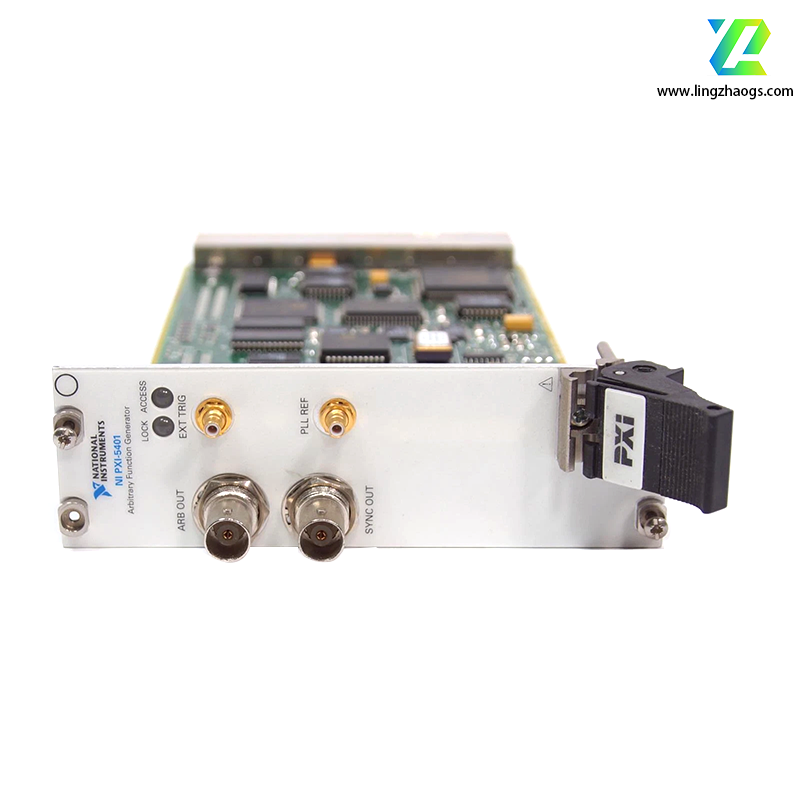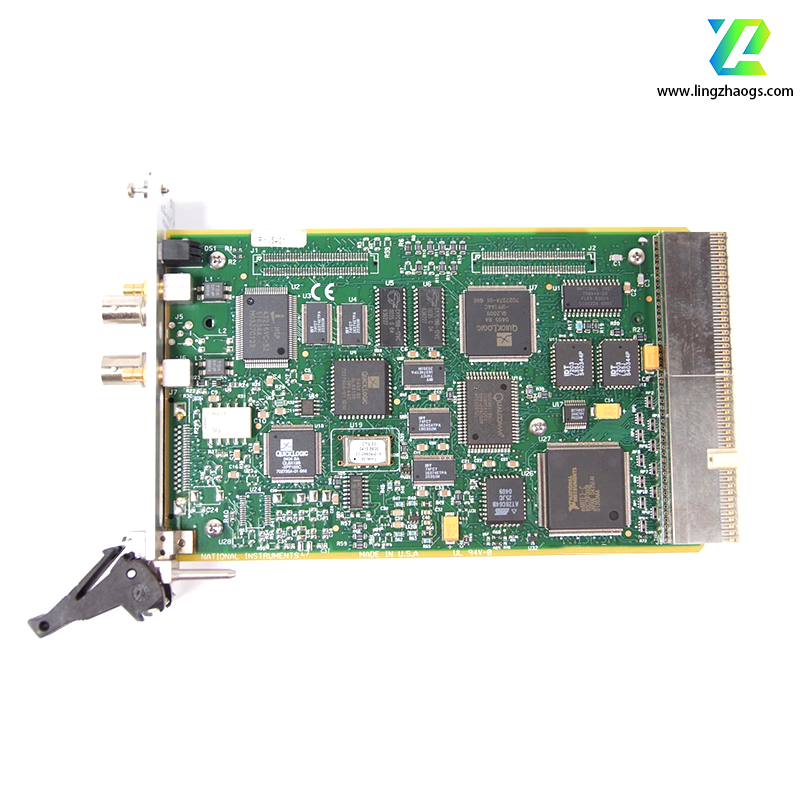The NI PXIe-5401 is a high-performance function and arbitrary waveform generator (AWG) designed for the PXI Express (PXIe) bus architecture, belonging to National Instruments (NI)’s RF and mixed-signal test product line. Its defining features include 1.2 GS/s real-time sampling rate, 14-bit resolution, and 250 MHz analog bandwidth—enabling it to generate high-fidelity, high-frequency signals for applications such as semiconductor test, radar simulation, and communication system validation. With PXIe’s high bandwidth and modular synchronization, it integrates seamlessly into multi-instrument test systems for R&D and production.
- Module Series: PXIe High-Speed Function/Arbitrary Waveform Generator
- Part Number: 780533-01 (standard model)
- Physical Dimensions: 1-slot 3U PXIe form factor, 10.0 cm × 16.0 cm (width × length)
- Weight: Approximately 0.8 kg (1.76 lbs)
- Power Requirements:
- +3.3 V DC (2.5 A)
- +12 V DC (1.8 A)
- -12 V DC (0.5 A)
- Power consumption: Typical 30 W, Maximum 40 W
- Interface Type:
- PXIe x1 lane (up to 8 GB/s data transfer rate) for fast waveform uploads
- 1 SMA female connector (analog output) for signal delivery
- 1 26-pin D-Sub connector for auxiliary digital I/O and trigger signals
- Operating Temperature Range: 0°C ~ 55°C (commercial grade)
- Environmental Ratings:
- Shock Resistance: 50 g peak (11 ms duration, half-sine)
- Vibration Resistance: 2 g RMS (10 Hz ~ 500 Hz, random)
- Ingress Protection: IP30 (prevents solid foreign object intrusion)
- Compliance: Meets FCC Part 15 Class A, CE EN 61326-1, UL 61010-1, and IEC 61010-1 safety & EMC standards
- Analog Bandwidth: 250 MHz (typical, for sine waves)
- Real-Time Sampling Rate: 1.2 GS/s (max), 600 MS/s (single-ended mode)
- Resolution: 14-bit (16,384 levels), ensuring low quantization noise for high-fidelity signals
- Output Amplitude:
- Peak-to-peak (pp): 200 mV ~ 2 V (into 50 Ω load)
- Offset: ±1 V (adjustable, independent of amplitude)
- Output Impedance: 50 Ω (matched, minimizes signal reflection)
- Signal Fidelity:
- Total Harmonic Distortion + Noise (THD+N): ≤-65 dBc (1 kHz sine wave, 1 Vpp into 50 Ω)
- Spurious-Free Dynamic Range (SFDR): ≥70 dBc (10 MHz sine wave, typical)
- Phase Noise: -95 dBc/Hz (10 MHz carrier, 1 kHz offset, typical)
- Function Generator Mode: Predefined standard waveforms with adjustable parameters:
- Sine: 1 Hz ~ 250 MHz (frequency), 0° ~ 360° (phase), 1% ~ 99% (duty cycle for square waves)
- Square: 1 Hz ~ 100 MHz (frequency), 200 ps (rise/fall time, typical)
- Triangle/Sawtooth: 1 Hz ~ 50 MHz (frequency)
- DC: 0 V ~ ±1 V (offset, with amplitude set to 0)
- Arbitrary Waveform Mode:
- Waveform Length: Up to 16 MSa (megasamples) of onboard memory (expandable via PXIe DMA)
- Sample Depth: 16-bit (internal storage, for high-resolution custom waveforms)
- Supported Formats: CSV, TXT, or NI binary (.wfm) files; importable from MATLAB/LabVIEW
- Playback Modes: Continuous, single-shot, or triggered burst (1 ~ 1,000,000 cycles)
- Pulse Mode:
- Pulse Width: 1 ns ~ 1 s (adjustable)
- Rise/Fall Time: 200 ps (typical, into 50 Ω)
- Delay: 0 ns ~ 1 s (relative to trigger)
- Clock Sources:
- Internal: 100 MHz OCXO (Oven-Controlled Crystal Oscillator), stability ±0.01 ppm/year
- External: 10 MHz reference input (via auxiliary connector) for system timing alignment
- PXIe 10 MHz Backplane Clock: Synchronizable with other PXIe modules (e.g., digitizers, SMUs)
- Trigger Options:
- Digital Trigger: TTL-compatible edge trigger (rising/falling) via auxiliary I/O or PXIe trigger lines (PXIe_Trig 0~7)
- Analog Trigger: Trigger on external analog signal threshold (0.1 V ~ 1.9 V into 50 Ω)
- Software Trigger: API-initiated trigger for automated test sequences
- Trigger Delay: 0 ns ~ 1 s (adjustable, for time-aligned multi-signal generation)
- Multi-Module Sync:
- Supports PXIe Star Trigger for nanosecond-level phase alignment across multiple PXIe-5401 modules
- Clock synchronization via PXIe backplane enables MIMO (Multiple-Input Multiple-Output) signal generation
- Onboard Memory: 16 MSa (for arbitrary waveform storage), supports segmented waveform playback (up to 1,024 segments)
- DMA Transfer: High-speed PXIe DMA for continuous waveform uploads (no memory bottleneck for long custom waveforms)
- Waveform Upload Speed: Up to 100 MB/s (via PXIe), reducing setup time for large arbitrary waveforms
- Recommended Software:
- NI-FGEN Driver (required for low-level hardware control and waveform configuration)
- LabVIEW 2020+ (for custom waveform design, test sequence development, and GUI creation)
- NI TestStand (for test automation, data logging, and report generation)
- NI SignalExpress (for quick, code-free waveform generation and validation)
- Programming Compatibility:
- NI Ecosystem: Native support for LabVIEW, LabWindows/CVI, and Measurement Studio
- Third-Party Languages: Supports C/C++, C#, Python (via NI-FGEN Python bindings), and MATLAB (via NI-FGEN Toolbox)
- Scripting: Supports Python/LabVIEW scripting for batch testing (e.g., generating 100+ unique test waveforms)
- Calibration Tools:
- Built-in automated calibration (via NI-FGEN) for amplitude, offset, and frequency accuracy correction
- Recommended calibration interval: 1 year (or after major temperature changes)
- External calibration support via NI Calibration Services (ISO 17025 accredited)
The NI PXIe-5401’s high speed and fidelity make it ideal for:
- Semiconductor Test: Generating test stimuli for analog/mixed-signal ICs (e.g., op-amps, ADCs/DACs) and high-speed digital chips (e.g., SerDes transceivers)
- Aerospace & Defense: Radar signal simulation (pulsed, FMCW), satellite communication waveform generation (QPSK, 8PSK), and avionics sensor testing
- Communication System Validation: 5G/LTE signal generation (OFDM waveforms) for baseband testing, and wireless LAN (Wi-Fi 6) signal simulation
- Automotive Electronics: Testing ADAS (Advanced Driver Assistance Systems) sensors (e.g., LiDAR signal emulation) and infotainment system audio/video signals
- Scientific Research: Generating custom stimuli for physics experiments (e.g., particle accelerator control) and biomedical device testing (e.g., ultrasound transducer drivers)
- Ideal Use Cases: Applications requiring 250 MHz bandwidth, 1.2 GS/s sampling rate, and PXIe integration; suitable for high-frequency, high-fidelity signal generation
- Comparison with Similar Models:
- vs. NI PXIe-5402: PXIe-5401 has 250 MHz bandwidth (vs. 500 MHz for PXIe-5402) but lower cost; choose for mid-frequency applications
- vs. NI PXIe-5673: PXIe-5401 is a baseband generator (vs. RF up to 3.6 GHz for PXIe-5673); ideal for baseband/mid-frequency testing
- System Integration:
- Chassis Compatibility: Works with all NI PXIe chassis (e.g., PXIe-1075, PXIe-1085) and third-party PXIe-compliant chassis
- Companion Modules:
- Digitizer: Pair with NI PXIe-5186 (1 GS/s, 14-bit) for stimulus-response testing
- Switch Matrix: Use NI PXIe-2597 to route signals to multiple DUTs (Devices Under Test)
- Oscilloscope: Integrate with NI PXIe-5164 for signal validation
- Limitations: No built-in RF upconversion (requires external mixer for RF signals >250 MHz); single output channel (needs multiple modules for multi-channel generation)
- Alternative Models:
- Higher Bandwidth: NI PXIe-5402 (500 MHz, 1.2 GS/s)
- RF Capability: NI PXIe-5673 (3.6 GHz vector signal generator)
- Multi-Channel: NI PXIe-5413 (2 channels, 200 MHz, 1 GS/s)
- Lower Cost: NI USB-5401 (USB interface, 250 MHz, entry-level)



